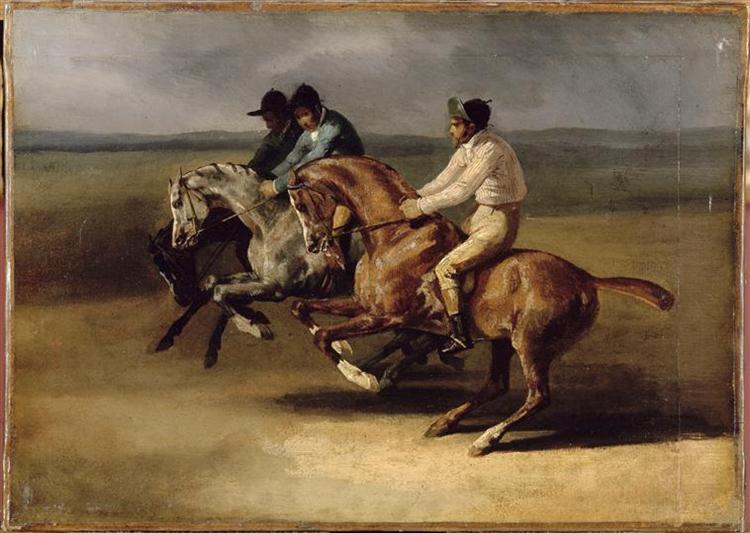Description
The work "La Carrera de Hablos" (1824) by Théodore Géricault is presented as a brilliant manifestation of the technical ability and dynamism inherent in the romantic movement in art. Géricult, known for his ability to capture emotion and intensity, captures in this painting a vibrant moment that not only celebrates the energy of the equestrian competition, but also reflects a deep understanding of the anatomy and dynamics of the movement.
When observing the composition, the asymmetric disposition stands out, where energetic horses and jockeys are thrown towards victory in a space that suggests an atmosphere of controlled chaos. The way Géricault has organized the characters, divided between the frantic action of the race and the observers that contemplate the event, provides a sensation of immediacy. This duality between action and observation is a fundamental characteristic of romantic painting, where both human instincts and the aesthetic experience of the viewer are explored.
The color in "the horsepower" is masterfully used to emphasize movement and emotion. The palette presents a variety of terrible tones that add reality to the figures, contrasted with the bright flashes of the jockeys clothes, which capture the light and give a festive air to the scene. The horses are portrayed with a remarkable precision, showing both their musculature and the palpable energy in their movements, indicating the deep study that Géricault carried out on these animals.
The characters that populate the work convey a diversity of emotions; The concentration of the jockeys, the anxiety of the horses and the expectation of the spectators are intertwined in a painting that evokes both the fervor of the competition and the possible dramatic outcome of a career. Although they are not portrayed individually, their collective presence contributes to the visual narrative, echoing the shared experience of the event.
The context in which this work was created is also significant. Géricult, a pioneer of romanticism, explored issues of humanity, nature and passion. Through his works, he often focused on the individual's struggle, which is reflected in the tension of the career, symbolizing not only a simple sporting event, but a battle for supremacy and recognition. Painting can be read, in a sense, as a metaphor for the broader struggles in life and art, which resonate in the context of their time.
The "horse race" can be compared to other works that exhibit the same approach to dynamism and tension, such as paintings From Eadweard Very Bridge about the movement or the famous "Los Mamelucos" of Géricault, which also explores the frantic movement. However, this work stands out for its focus on the speed and fervor of the competition, capturing the essence of an ephemeral moment with a mastery that invites the viewer to experience the adrenaline of the scene represented.
In summary, "the horse career" of Théodore Géricault is presented not only as an exceptional example of the artist's technical ability, but also as a work that encapsulates the values of romanticism through its vivid and emotional representation of a moment of a moment of a moment of action. It is a celebration of life, struggle and beauty, reflected in the elegant but frantic movement of horses and their riders.
KUADROS ©, a famous paint on your wall.
Hand-made oil painting reproductions, with the quality of professional artists and the distinctive seal of KUADROS ©.
Reproduction service paintings With a guarantee of satisfaction. If you are not completely satisfied with the replica of your painting, we refund your money 100%.

